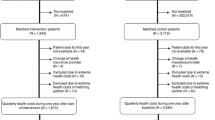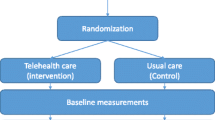Abstract
Background
Advances in telehealth are proving to be extremely conducive to effective management of congestive heart failure (CHF) and other disease states, particularly in ambulatory settings. In order to assess the impact of telehealth on healthcare utilization in CHF patients, telehealth technology was introduced into a demonstration project established by the Secretary of Health and Human Services. Demonstration projects examine health delivery factors that encourage the delivery of improved quality of care and have already implemented protocols to evaluate methods to improve quality of care and reduce expenditures provided to Medicare beneficiaries with chronic conditions (including methods to permit Medicare beneficiaries to direct their own healthcare needs and services). This study, funded in June of 2002 by the Centers for Medicare and Medicare Services, focused on The Jewish Home & Hospital Services, Lifecare Plus (New York, NY, USA), one of the US’s federally funded national demonstration projects. The study measured the impact of managing CHF patients via telehealth technology on overall healthcare utilization, physician office visits, emergency department (ED) visits, and hospital readmissions.
Methods
To be eligible for the Jewish Home & Hospital Services Lifecare Plus demonstration project, patients had to be aged ≥65 years, have both Medicare parts A & B, have had at least three doctor visits or one hospitalization in the previous 12 months, reside at a Manhattan or Bronx address in New York, and have one of the following diagnoses: heart disease, diabetes, liver disease, lung disease, vascular disease, cerebrovascular disease, psychotic major depression or anxiety, cancer, Alzheimer disease, or dementia. This particular study included 20 homebound CHF patients, of whom 10 were in the telehealth study group and 10 were in the control group.
Results
The findings demonstrated that patients managing their CHF via telehealth technology decreased their overall utilization of healthcare resources by 41% (p = 0.00183). Physician office visits decreased by 43% (p = 0.00253), ED visits by 33% (p = 0.3770), and hospitalizations by 29% (p = 0.3872).
Conclusions
The significant reduction in overall healthcare utilization and physician office visits demonstrate that this technology could offer significant cost savings for long-term disease management and could offer clinicians a new form of service delivery that may improve the quality of care. Hopefully, the outcomes of this study will serve as a catalyst for future larger studies, thus reducing the obvious limitations associated with small studies such as this one.

Similar content being viewed by others
References
Thom T, Haase N, Rosamond W, et al. Heart disease and stroke statistics — 2006 update: a report from the American Heart Association Statistics Committee and Stroke Statistics Subcommittee. Circulation 2006; 113: e85–el51
Robinson D, Rogers R. The clinical challenge of congestive heart failure: optimizing outcomes in the emergency department and outpatient setting. Emergency Medicine Reports [online]. Available from URL: http://www.unityhealthresidency.org/pdf/ED/CHF.pdf [Accessed 2006 Apr 7]
Massie BM, Shah NB. Evolving trends in the epidemiologic factors of heart failure: rationale for preventive strategies and comprehensive disease management. Am Heart J 1997; 133: 703–12
Jerant AF, Azari R, Nesbitt TS. Reducing the cost of frequent hospital admissions for congestive heart failure. Med Care 2001; 39(11): 1234–45
National Heart, Lung, and Blood Institute. Data fact sheet: congestive heart failure in the United States: a new epidemic [online]. Available from URL: http://www.nhlbi.gov/healyh/public/heart/other/chf.htm [Accessed 2006 Feb]
Federal Interagency Forum on Aging-Related Statistics. Older Americans 2004: key indicators of well-being. Washington, DC: US Government Printing Office, 2004 Nov
United Nations. Report of the Second World Assembly on Aging; Madrid 8–12 April 2002 [online]. Available from URL: http://daccessdds.un.org/doc/UN-DOC/GEN/N02/397/51/PDF/N0239751.pdf?.OpenElement [Accessed 2006 Apr 7]
Kinsella K, Velkoff VA. An aging world: 2001. US Census Bureau Series P95/01–1 [online]. Available from URL: http://www.census.gov/prod/2001pubs/p95-01-1.pdf [Accessed 2006 Apr 7]
US Department of Veterans Affairs. Report on approaches to make health information systems available and affordable to rural and medically underserved communities, in cooperation with the Department of Defense [online]. Available from URL: http://www.hhs.gov/healthit/attachment_2/attachment_2.html [Accessed 2006 Apr 7]
Kleinpell RM, Avitall B. Telemanagement in chronic heart failure: a review. Dis Manage Health Outcomes 2005; 13(1): 43–52
Louis AA, Turner T, Gretton M, et al. A systematic review of telemonitoring for the management of heart failure. Eur J Heart Fail 2003; 5(5): 583–90
Longino CF. Myths of an aging America. American Demographics 1994 Aug; 16(8): 36–42
Australian Government Department of Health & Ageing. Australia/Japan: a comparison of aged care in Australia and Japan [online]. Available from URL: http://www.health.gov.au/internet/wcms/Publishing.nsf/Content/ageing-publicatausjap.htm/$file/austjap.pdf [Accessed 2006 Apr 7]
Lehmann C. The future of home testing: implications for traditional laboratories. Clin Chim Acta 2002 Sep; 323(1–2): 31–6
Yu C-M, Wang L, Chau E, et al. Intrathoracic impedance monitoring in patients with heart disease: correlation with fluid status and feasibility of early warning preceding hospitalization. Circulation 2005; 112: 841–8
National Institutes of Health. NIH news release: study offers new insights into overcoming disparities in health [online]. Available from URL: http://www.nih.gov/news/pr/jul2002/nia-22.htm [Accessed 2006 Apr 7]
Cheung DS, Heizer D, Wilson J, et al. Cost-savings analysis of using a portable coagulometer for monitoring homebound elderly patients taking warfarin. Am J Geriatr Cardiol 2003; 12(5): 283–7
US Social Security Administration. Title XVIII of Social Security Act (42 USC 1395 et. seq.) 1866B Healthcare Quality Demonstration Program section 1866C [online]. Available from URL: http://www.ssa.gov/OP_Home/ssact/title18/1800.htm [Accessed 2006 Apr 7]
Centers for Medicare & Medicaid Services. Details for demonstration project for consumer-directed chronic outpatient services [online]. Available from URL: http://www.cms.hhs.gov/researchers/demos/CDCOS/default.asp [Accessed 2006 Apr 7]
Fleishman V, Sclar DI. New England Healthcare Institute. Remote physiological monitoring: innovation in the management of heart failure [online]. Available from URL: http://www.nehi.net/CMS/admin/cms/_uploads/docs/HF%20Report.pdf [Accessed 2006 Apr 7]
Foote SM. Population-based disease management under fee-for-service Medicare. Health Aff 2003 Jul; 22(4): W3342–W3356
International Council of Nurses. Global issues in the supply and demand of nurses. Socio-Economic News 2003 Jan–Mar [online]. Available from URL: http://www.icn.ch/sewjan-march03.htm [Accessed 2006 Apr 7]
Joint Commission on Accreditation of Healthcare Organizations. Healthcare at the crossroads: strategies for addressing the evolving nursing crisis [online]. Available from URL: http://www.jointcommission.org/NR/rdonlyres/5C138711-ED76-4D6F-909F-B06E0309F36D/0/health_care_at_the_cross-roads.pdf [Accessed 2006 Apr 7]
Pan American Health Organization. Promoting health in the Americas: Dominican Republic [online]. Available from URL: http://www.paho.org/english/sha/prfldor.htm [Accessed 2006 Feb]
American Medical Directors Association. Senate Aging Committee examines shortages in geriatric care [online]. Available from URL: http://ww-w.amda.com/federalaffairs/newsletters/march2002/shortage.htm [Accessed 2006 Apr 7]
Acknowledgments
The authors wish to thank Professor Thomas Sexton, PhD, of the Harriman School for Policy and Management (Stony Brook, University, Stony Brook, NY, USA) for his statistical analysis. No sources of funding were used to assist in the preparation of this study. Dr Lehmann serves as a consultant to Bayer Diagnostics Division, Bayer HealthCare LLC (Tarrytown, NY, USA), one of the parent companies of Viterion TeleHealthcare LLC. The authors have no conflicts of interest that are directly relevant to the content of this study.
Author information
Authors and Affiliations
Corresponding author
Rights and permissions
About this article
Cite this article
Lehmann, C.A., Mintz, N. & Giacini, J.M. Impact of Telehealth on Healthcare Utilization by Congestive Heart Failure Patients. Dis-Manage-Health-Outcomes 14, 163–169 (2006). https://doi.org/10.2165/00115677-200614030-00005
Published:
Issue Date:
DOI: https://doi.org/10.2165/00115677-200614030-00005




